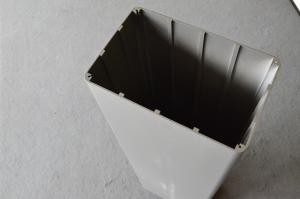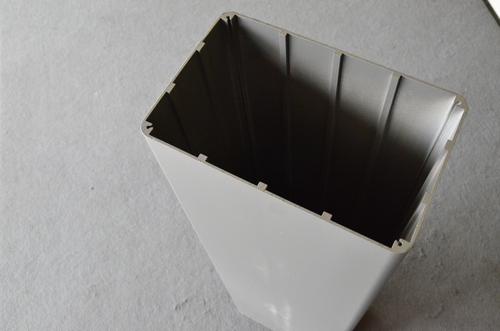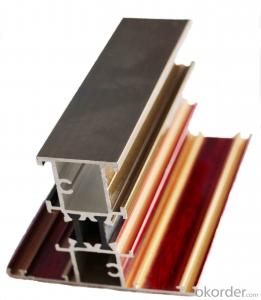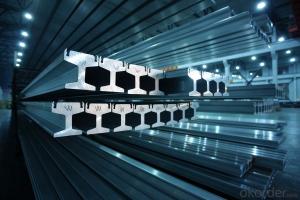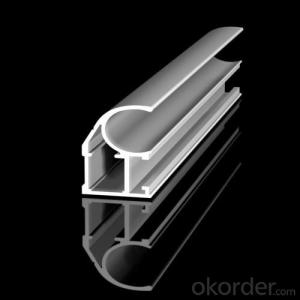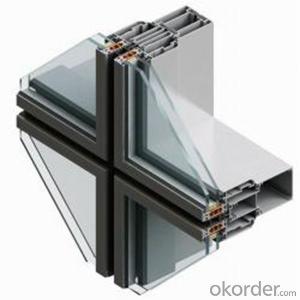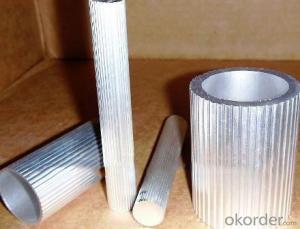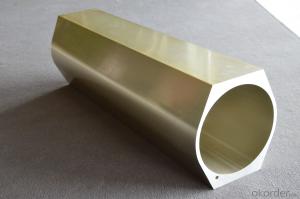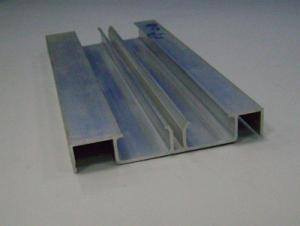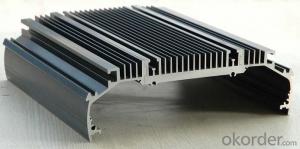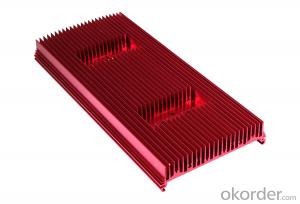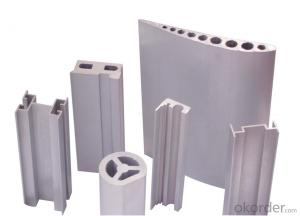Aluminum Extrusion Tube Profiles - Aluminum Sections 04
- Loading Port:
- China Main Port
- Payment Terms:
- TT OR LC
- Min Order Qty:
- -
- Supply Capability:
- -
OKorder Service Pledge
OKorder Financial Service
You Might Also Like
Industrial aluminium profile
1)Material : 6063 6061 6060 and different aluminium alloy
2)Status:T4 T5 T6 or other special status
3)Surface treatment: mill finish, anodized sliver ,anodized bronze, anodized champagne, anodized black pearl, various power coating color, electrostatic sliver, electrostatic champagne, electrostatic golden, electrostatic titanium , machine polish sliver, machine polish bronze, wooden grain color, and Fluorocarbon spraying.
4)Annual capacity : 120000TON
5)Quality : China Nation Standard GB/T 5237 2008 (advanced class)
6)Use: can be widely using aluminium window, door, curtain wall, hand railing , normal aluminium profile, decorative and industrial aluminium profile
7)Advantage: Famous Brand reasonable&market price, soonest delivery and good after sale- service
8)Type of package:protection foam+heat contracted plastic film. / wooden packing / Metal pallet or depand on clientspecial requirement.
9)Payment term:T/T:30% of total value as deposite should paid by T/T within 3 days when confirmation ,and the remaining sum should be paid by T/T before delivery.L/C: 100% at sight
10)Delivery Day: 15-30days
11)Honor : CHINA FAMOUS TRADEMARK, CHINA TOP BRAND, ISO9001-2000, CHINA SQUARE&ROUND COMMITTEE DNV
- Q: How do aluminum profiles contribute to sustainable transportation solutions?
- Aluminum profiles play a significant role in promoting sustainable transportation solutions in several ways. Firstly, aluminum is a lightweight material, which means it can significantly reduce the weight of vehicles such as cars, buses, trains, and airplanes. This reduction in weight leads to improved fuel efficiency and lower greenhouse gas emissions. By using aluminum profiles in the manufacturing process, vehicles consume less energy and produce fewer pollutants, making them more environmentally friendly. Secondly, aluminum is a highly recyclable material. It can be easily recycled and reprocessed, allowing for the creation of new aluminum profiles without compromising their quality or performance. This recyclability aspect promotes a circular economy, reducing the need for extracting and refining raw materials continually. It also decreases the amount of waste generated and minimizes the environmental impact associated with the production and disposal of aluminum profiles. Furthermore, aluminum profiles are durable and corrosion-resistant, which extends the lifespan of vehicles. The increased durability reduces the frequency of maintenance and replacements, leading to lower resource consumption and waste generation. Consequently, it contributes to a more sustainable transportation system by reducing the overall environmental impact associated with vehicle manufacturing and operation. Additionally, aluminum profiles can be designed to enhance aerodynamics and improve the overall performance of vehicles. By reducing drag and optimizing airflow, aluminum profiles contribute to increased fuel efficiency and reduced energy consumption. This improved performance not only benefits the environment but also reduces operational costs for transportation companies and individuals. Overall, the use of aluminum profiles in transportation solutions has a positive impact on sustainability. It reduces vehicle weight, promotes recycling, extends lifespan, and enhances performance, all of which contribute to a more eco-friendly and efficient transportation system. By embracing aluminum profiles, the transportation industry can take significant strides towards achieving a more sustainable and greener future.
- Q: Aluminum blackening formula
- Anodic oxidation of aluminum is aluminum or Aluminum Alloy anode to lead as cathode in sulfuric acid, oxalic acid, chromic acid and aqueous solution electrolysis, so that the surface oxide film. The anodic oxidation process is most widely used. Aluminum and Aluminum Alloy sulfuric acid anodizing oxidation film has high adsorption capacity, easy sealing alone or with colored more to improve the corrosion resistance of anodic oxide film thickness and appearance. The process is generally Aluminum Alloy sulfuric acid anodizing electrolyte has the advantages of simple operation, stable, cost is not high, the process is mature, but in sulfuric acid anodized process often unavoidable failure occurred, influence of oxide film quality. The following detailed analysis about the failure reasons, then give some preventive measures for your reference:Common faults and analysisAluminum Alloy products by sulfuric acid anodic oxidation, partial oxidation without touch, showing visible black spots or stripes, film drums or holes. The failure phenomenon of tumor is rare but has occurred.Dr. al website has detailed knowledge
- Q: What are the impact resistance properties of aluminum profiles?
- Aluminum profiles have excellent impact resistance properties due to their inherent strength and durability. They can withstand high impact forces without deforming or breaking, making them suitable for various applications where impact resistance is crucial, such as automotive, construction, and aerospace industries. Additionally, aluminum profiles can absorb and distribute impact energy effectively, minimizing the risk of damage or injury.
- Q: What are the dimensions and sizes of aluminum profiles?
- The dimensions and sizes of aluminum profiles can vary greatly depending on their intended use and design. They can range from small and narrow profiles, such as 10mm x 10mm square tubes, to larger and wider profiles, such as 100mm x 100mm square tubes. Additionally, aluminum profiles can come in various shapes, including square, rectangular, round, and custom shapes, to accommodate different applications and structural requirements. It is important to consult specific product catalogs or manufacturers for precise dimensions and sizes of aluminum profiles.
- Q: What are the applications of aluminum profiles?
- Aluminum profiles have a wide range of applications in various industries due to their unique characteristics and properties. Some of the main applications of aluminum profiles include: 1. Construction: Aluminum profiles are extensively used in the construction industry for windows, doors, curtain walls, and structural components. They provide excellent strength, durability, and resistance to corrosion, making them ideal for building purposes. 2. Automotive: Aluminum profiles are used in the automotive industry for manufacturing lightweight and fuel-efficient vehicles. They are utilized in the production of car frames, engine mounts, heat exchangers, and other structural components. 3. Aerospace: Aluminum profiles find significant applications in the aerospace industry due to their high strength-to-weight ratio. They are used in the construction of aircraft frames, wings, fuselage, and other critical components. 4. Electrical and Electronics: Aluminum profiles are widely used in electrical and electronics applications. They are utilized in the manufacturing of heat sinks, LED lighting fixtures, electrical enclosures, and electronic device housings due to their excellent thermal conductivity and electrical insulation properties. 5. Furniture: Aluminum profiles are increasingly being used in the furniture industry for manufacturing lightweight and stylish furniture pieces. They are utilized in the production of chairs, tables, cabinets, and shelving systems, providing a modern and aesthetic appeal. 6. Industrial Machinery: Aluminum profiles are extensively used in the manufacturing of industrial machinery and equipment. They are utilized in the construction of conveyor systems, assembly line structures, machine frames, and guarding systems due to their lightweight, durability, and ease of fabrication. 7. Marine: Aluminum profiles are commonly used in the marine industry due to their corrosion resistance and lightweight properties. They are utilized in the construction of boat frames, masts, hulls, and other marine structures. 8. Renewable Energy: Aluminum profiles find applications in renewable energy systems such as solar panels and wind turbines. They are used in the manufacturing of solar panel frames, wind turbine supports, and mounting structures due to their lightweight and corrosion resistance. Overall, aluminum profiles offer a versatile and cost-effective solution for various industries, catering to their specific requirements for strength, durability, lightweight, and corrosion resistance.
- Q: This question asks for a list of various materials that are used in the production of aluminum profiles.
- <p>Aluminum profiles are primarily made from aluminum alloys, which are composed of aluminum combined with other elements to enhance their properties. Common materials used include 6063 aluminum alloy, known for its excellent extrudability and weldability, making it ideal for a wide range of applications. 6061 aluminum alloy is also used for its high strength and good corrosion resistance, suitable for structural components. Other alloys such as 6082 and 7075 are utilized for their superior strength-to-weight ratios, often found in aerospace and automotive industries. Additionally, aluminum profiles may incorporate materials like magnesium, silicon, copper, and manganese to achieve specific mechanical properties or corrosion resistance tailored to particular applications.</p>
- Q: Are aluminum profiles suitable for exhibition booths?
- Yes, aluminum profiles are suitable for exhibition booths. They are lightweight, durable, and easy to assemble and disassemble, making them ideal for creating versatile and portable booth structures. Additionally, aluminum profiles offer a sleek and modern aesthetic, allowing for customization and branding opportunities.
- Q: How do you prevent galvanic corrosion with aluminum profiles?
- To prevent galvanic corrosion with aluminum profiles, several measures can be taken. Firstly, it is essential to ensure that the aluminum profiles are not in direct contact with dissimilar metals, especially those that have a higher electrochemical potential. This can be achieved by using insulating materials, coatings, or gaskets between the aluminum profiles and other metals. Additionally, applying protective coatings or anodizing the aluminum surfaces can provide a barrier against corrosion. Regular maintenance, including cleaning and inspection, is also crucial to identify any potential corrosion risks and address them promptly.
- Q: Is it possible to utilize recycled aluminum from various sources to manufacture new aluminum profiles?
- <p>Yes, recycled aluminum can be used to create new aluminum profiles. The process involves melting down the recycled aluminum, which can then be reformed into new shapes and profiles. This not only conserves resources but also reduces energy consumption compared to producing aluminum from raw materials. Recycled aluminum maintains its properties, making it suitable for a wide range of applications, from construction to automotive industries.</p>
- Q: This question asks for the typical specifications and measurements of aluminum profiles that are used in the construction of building frames.
- <p>Aluminum profiles used in building frames come in various specifications and measurements. Commonly, they include I-beams, T-profiles, and C-channels with different thicknesses and dimensions. Sizes can range from 30mm to 200mm in width and from 1mm to 10mm in thickness. The length of these profiles can vary, but they are often available in standard lengths such as 6 meters. Specific dimensions and tolerances are determined by the building's design requirements, load-bearing needs, and manufacturing standards. It's also important to consider the alloy type, which can affect strength and corrosion resistance. Always consult with an engineer or supplier for the exact specifications suitable for a particular project.</p>
Send your message to us
Aluminum Extrusion Tube Profiles - Aluminum Sections 04
- Loading Port:
- China Main Port
- Payment Terms:
- TT OR LC
- Min Order Qty:
- -
- Supply Capability:
- -
OKorder Service Pledge
OKorder Financial Service
Similar products
Hot products
Hot Searches
Related keywords
